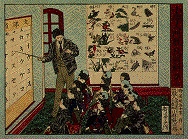
|
NATIONAL INSTITUTE FOR EDUCATIONAL RESEARCH LIBRARY OF EDUCATION
|
|
|
As automated switchboards are introduced, revision of telephone books is studied. Although the school system has long adopted the modern, regular "A-I-U-E-O" method of alphabetizing Japanese words, many users are still accustomed to the traditional, poem-based "I-RO-HA" order and take a dim view of the idea of writing numbers in arabic numerals instead of characters. Some fear that the use of horizontal script will lead to the loss of a part of Japanese culture. In the early Meiji years, the so-called 50-sound table of Japanese syllables (on which the "A-I-U-E-O" method is based) actually required students to learn as many as 96 'kana' symbols, including both 'hiragana' and traditional 'hentaigana' variant forms, in order to read. The simpler 'katakana' alphabet was considerably easier.
|